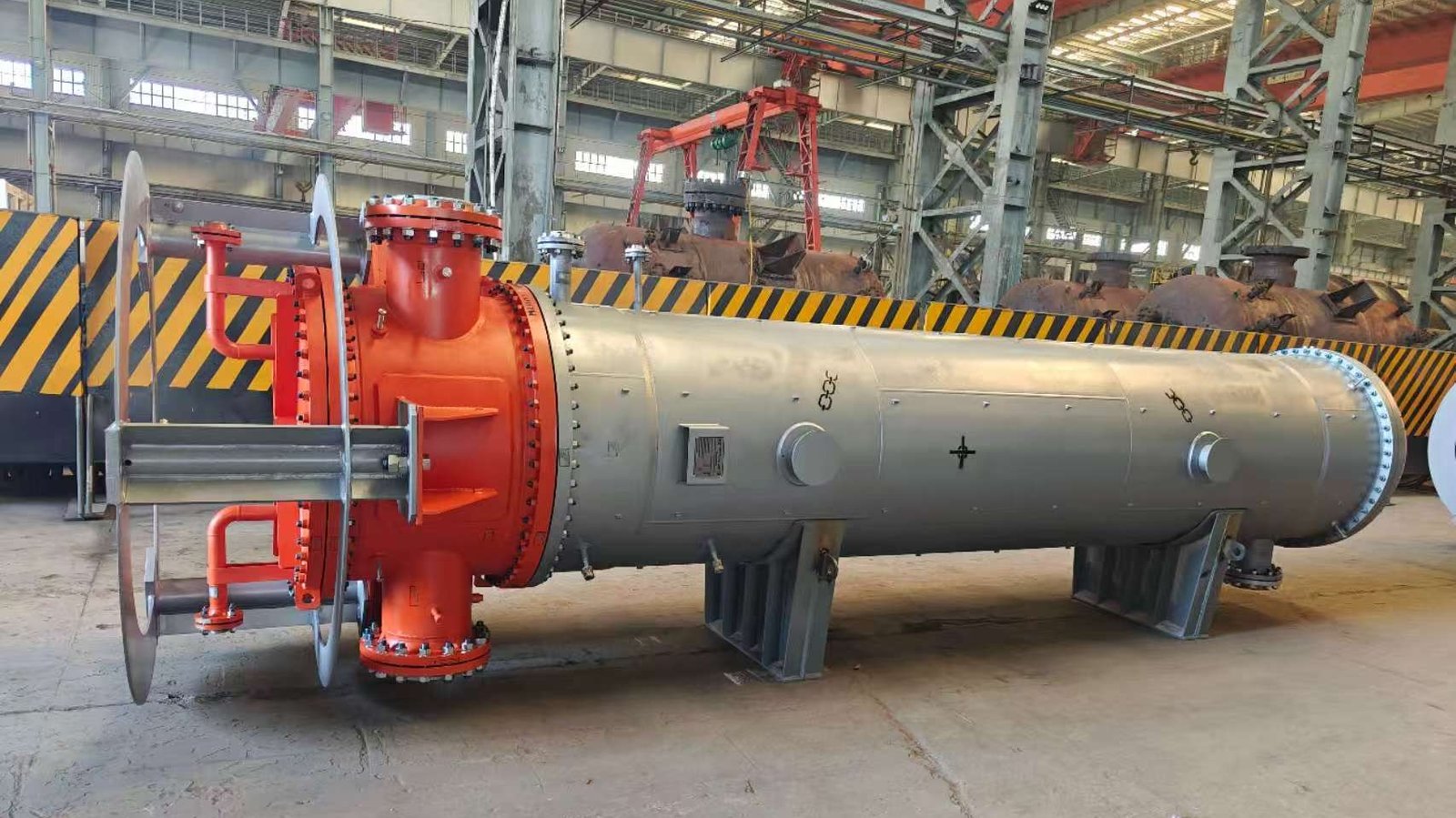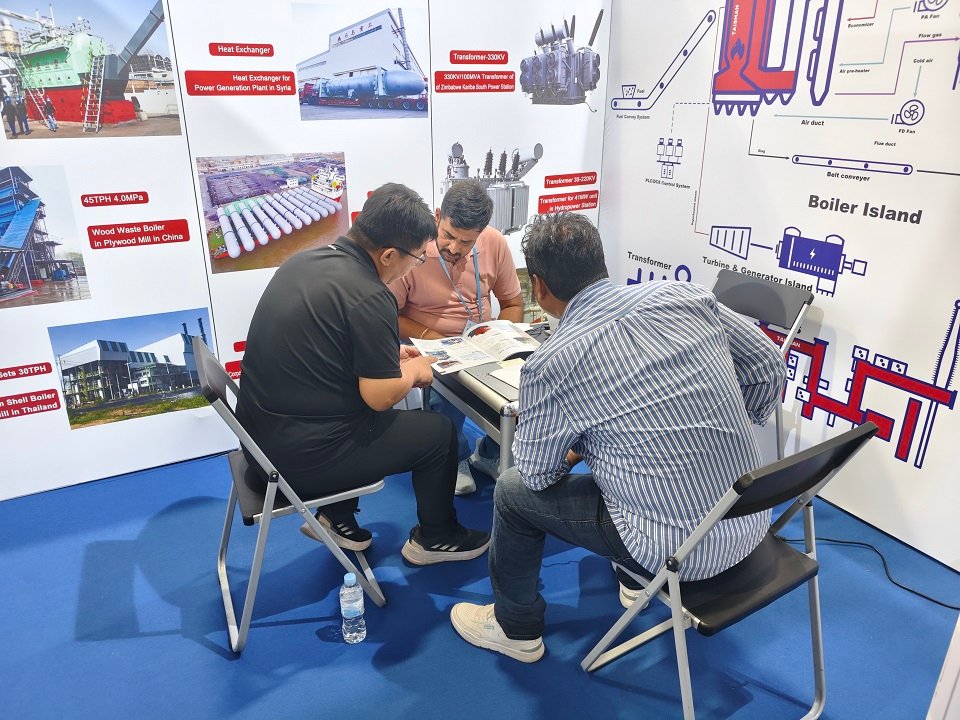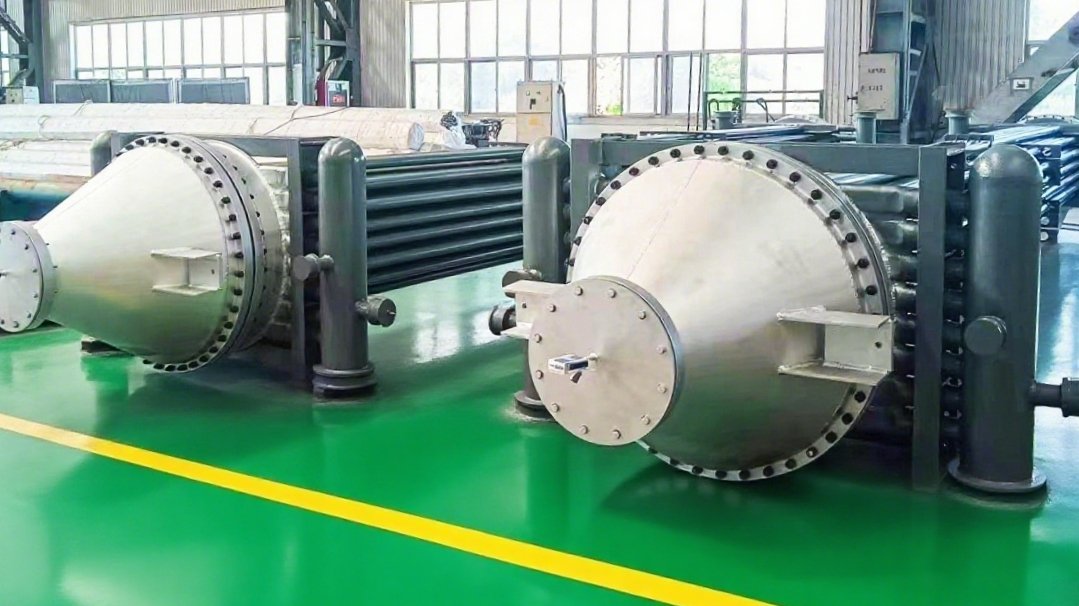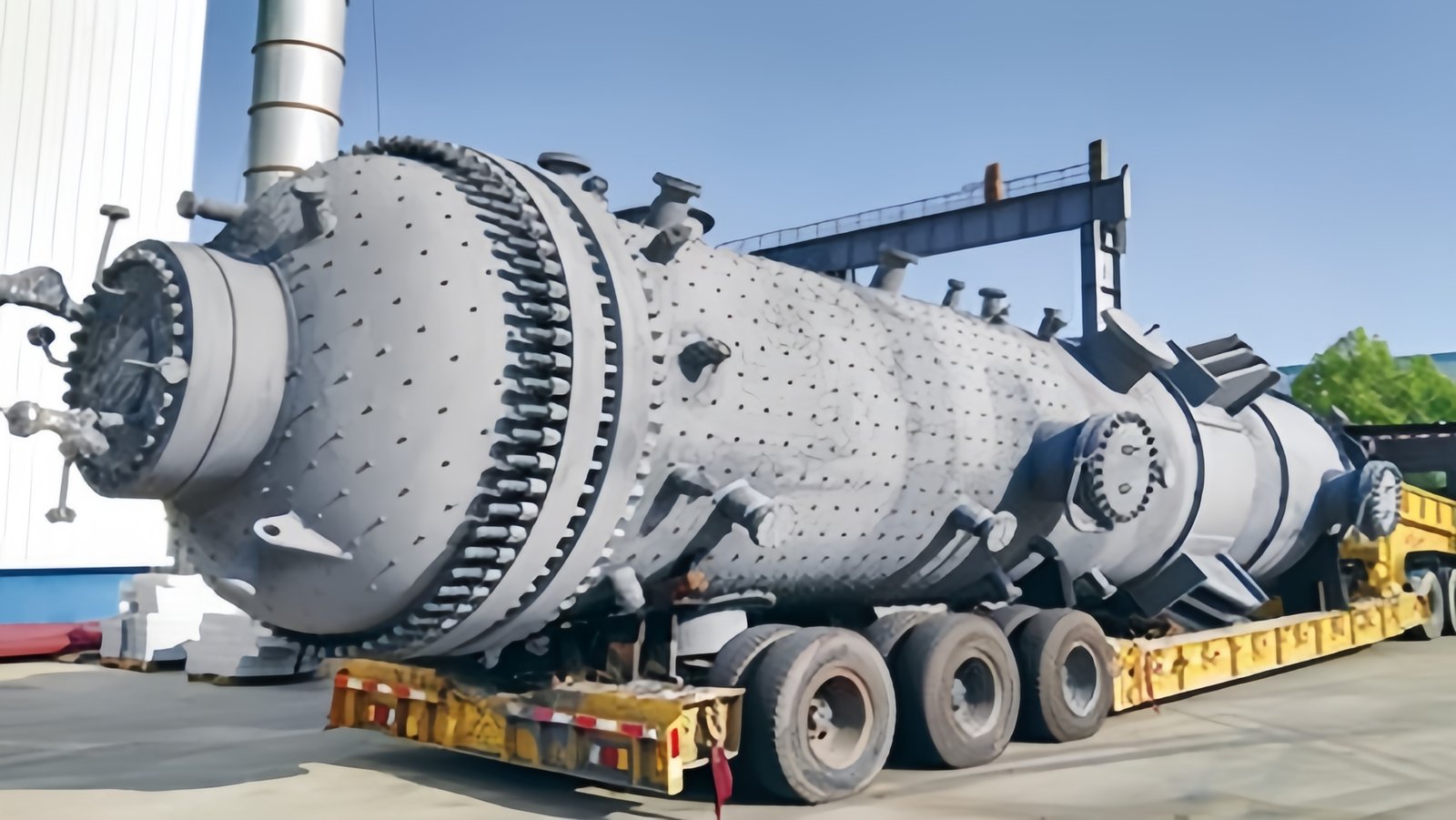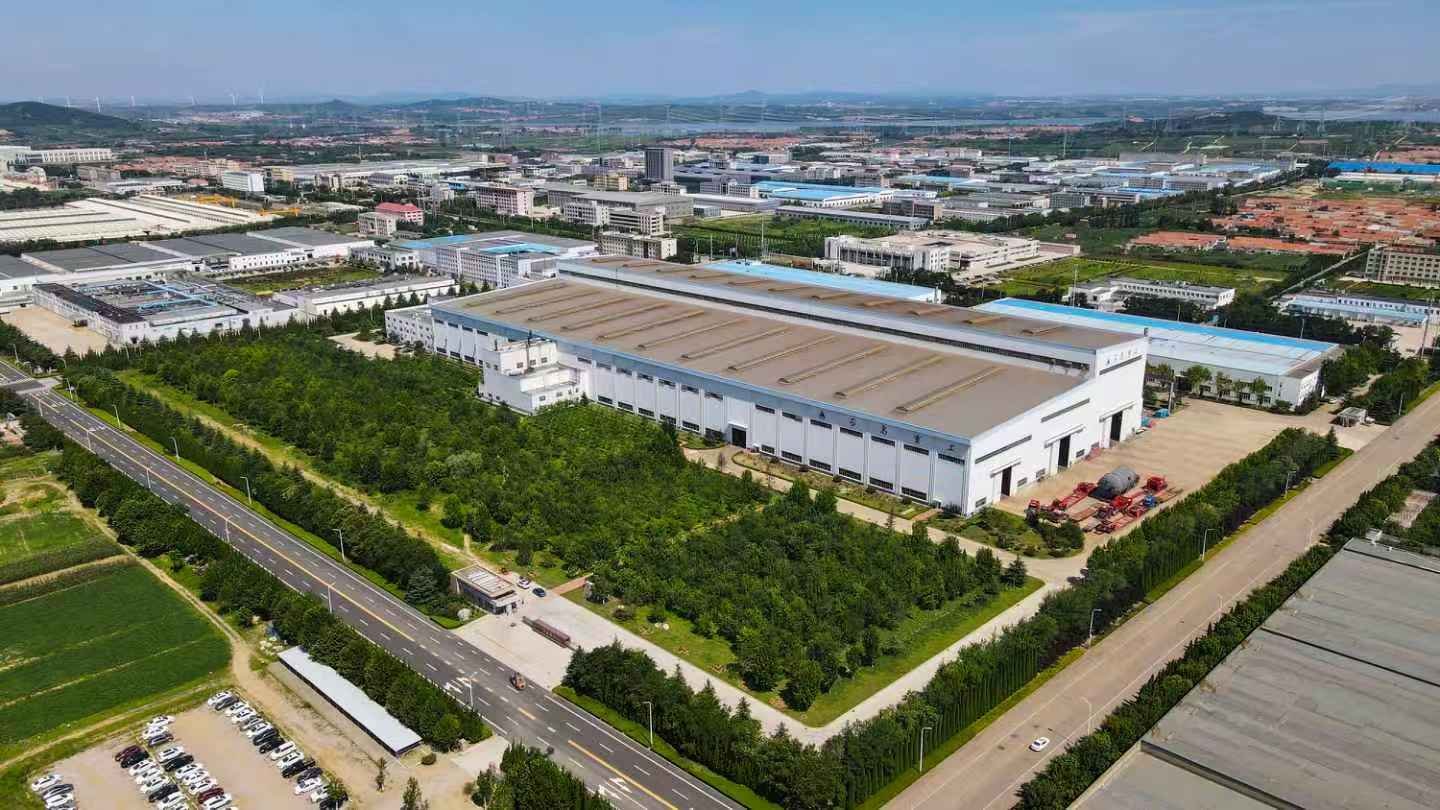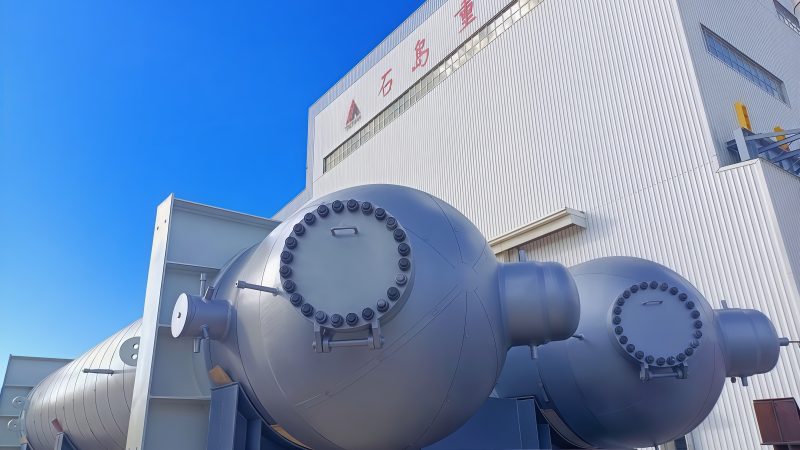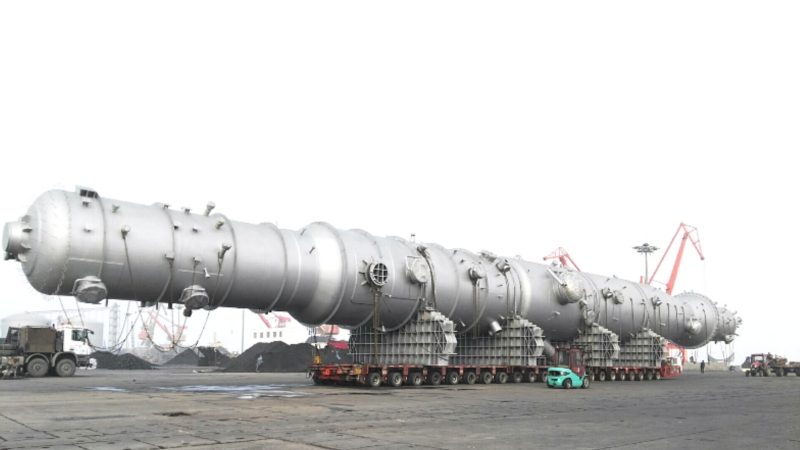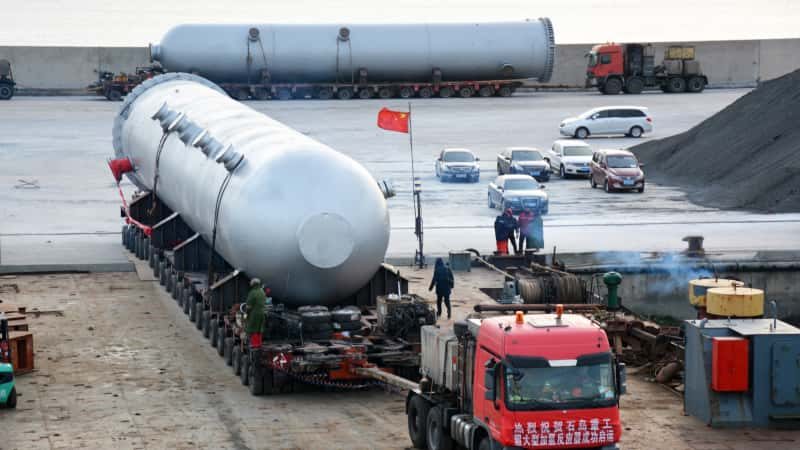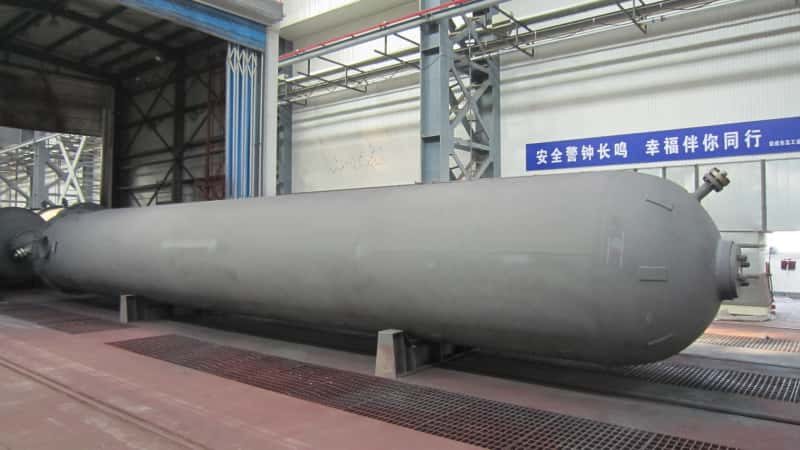In the field of chemical manufacturing, especially within fertilizer production and industrial chemical processes, the ammonia synthesis tower is a central piece of equipment. However, many engineers and procurement managers face serious challenges: selecting the wrong tower design or materials can lead to reduced efficiency, catalyst poisoning, frequent shutdowns, or even catastrophic failure. The consequences of poor selection are costly — from decreased yield to unscheduled downtime and safety risks. The solution lies in understanding the technical, operational, and economic factors involved in choosing the right ammonia synthesis tower tailored to your process conditions. This article will walk you through all the key considerations.
An ammonia synthesis tower is a high-pressure reactor where nitrogen and hydrogen gases react over a catalyst to form ammonia, and selecting the right tower involves evaluating factors like reaction pressure, catalyst type, heat exchange integration, material selection (typically alloy steel or stainless steel), internal design (tube- or shell-type flow), and process capacity requirements to ensure high conversion efficiency and operational safety.
If you’re designing a new ammonia plant or upgrading an old one, this article will help you clarify exactly what to look for in an ammonia synthesis tower so that your investment delivers long-term performance, safety, and output efficiency.
What Is an Ammonia Synthesis Tower and How Does It Work?
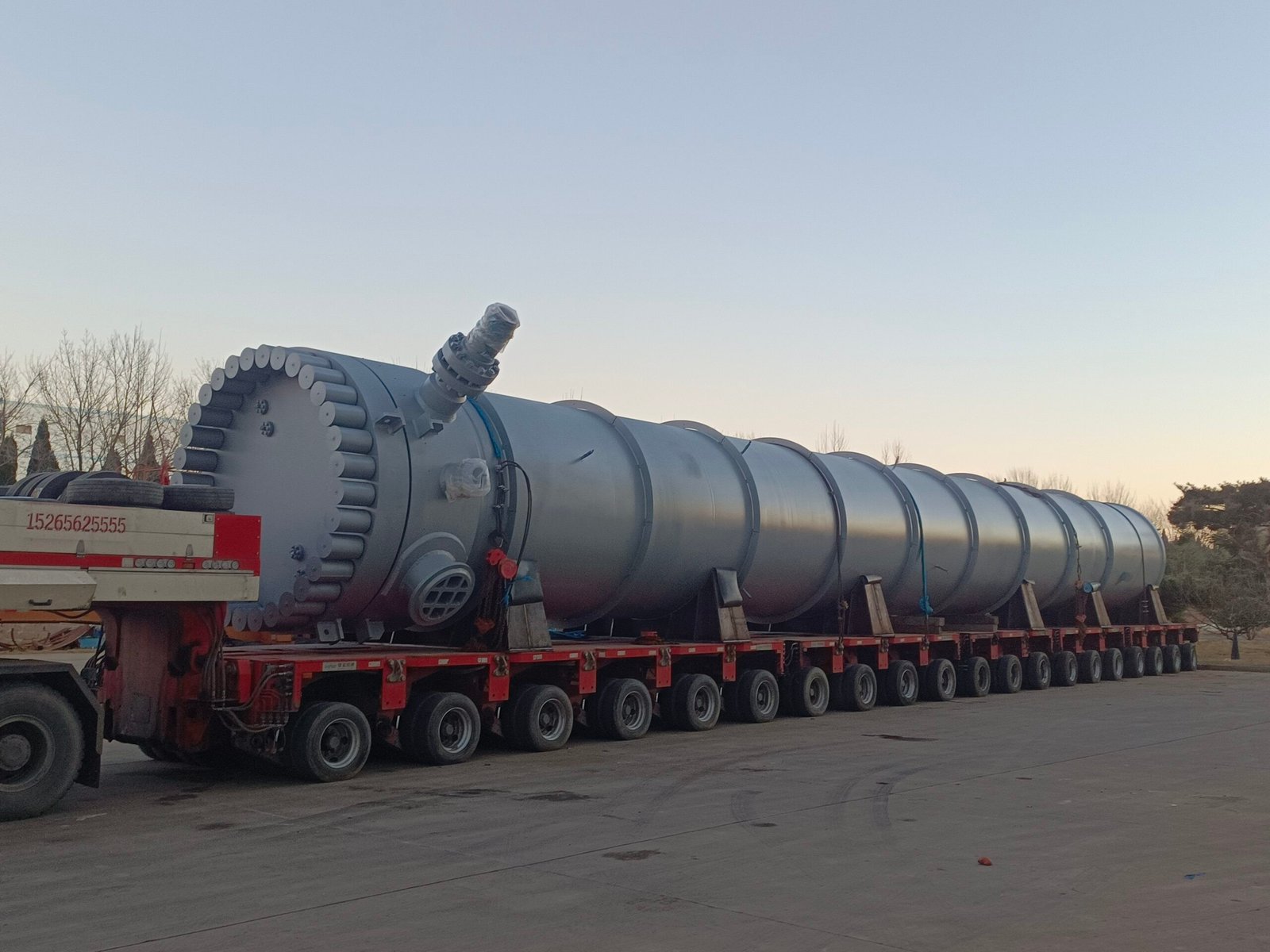
In the fertilizer, chemical, and energy industries, ammonia is one of the most vital base chemicals—but producing it efficiently and at scale poses significant technical challenges. A key part of the solution is the ammonia synthesis tower (also known as an ammonia converter), a high-pressure reactor designed to convert hydrogen and nitrogen into ammonia. If poorly designed or mismanaged, synthesis towers can be inefficient, costly, and even dangerous due to high-pressure operations. But with proper understanding, selection, and operation, they become the cornerstone of ammonia production plants—maximizing yield, energy efficiency, and safety. This article explores what ammonia synthesis towers are, how they work, and how to optimize their performance in industrial production.
An ammonia synthesis tower is a high-pressure, high-temperature reactor vessel used in the Haber-Bosch process to catalytically convert nitrogen and hydrogen gases into ammonia (NH₃), typically at pressures of 150–300 bar and temperatures around 400–500°C, using an iron-based catalyst; it operates continuously with heat recovery and multiple catalyst beds to maximize conversion efficiency.
For professionals working in ammonia plants or chemical process design, understanding the internal operation of the synthesis tower can dramatically improve plant efficiency and maintenance planning. Keep reading to gain deep technical insights, design principles, real-world examples, and optimization techniques for ammonia converters.
\
Ammonia synthesis towers operate at temperatures over 400°C and pressures exceeding 100 bar.True
These extreme conditions are required to achieve a practical conversion rate of nitrogen and hydrogen into ammonia in the Haber-Bosch process.
📌 Technical Overview of the Ammonia Synthesis Tower
The ammonia synthesis tower is a critical reactor in the Haber-Bosch process, the globally dominant method for ammonia production. In this process, purified hydrogen (H₂) and nitrogen (N₂) gases are reacted over a promoted iron catalyst at elevated pressures and temperatures. However, due to the exothermic and equilibrium-limited nature of the reaction:
\text{N}_2 + 3\text{H}_2 \rightleftharpoons 2\text{NH}_3 \quad \Delta H = -92 \text{ kJ/mol}
…only about 15–25% of the feed gases convert to ammonia per pass. To overcome this, the system is designed for recycling unreacted gases, maintaining high conversion efficiency over multiple passes.
🏗️ Anatomy of a Synthesis Tower
| Component | Function |
|---|---|
| Outer Pressure Shell | Contains the reactor internals and withstands high pressure (up to 300 bar). |
| Catalyst Beds (2–4) | Packed beds of iron-based catalyst where NH₃ synthesis occurs. |
| Heat Exchangers | Preheat incoming gas and recover heat from the exothermic reaction. |
| Internal Baffles | Guide gas flow and support catalyst beds. |
| Quenching Systems | Cool gases between beds to optimize temperature profiles. |
| Ammonia Condensers | Separate ammonia product from unreacted gases. |
| Gas Recycle Loop | Returns unreacted hydrogen and nitrogen to the inlet. |
⚙️ How the Ammonia Synthesis Process Works Inside the Tower
Once hydrogen and nitrogen (in a 3:1 ratio) are purified and compressed, they are preheated and fed into the reactor. Here’s how the process flows within the tower:
- Preheating and Entry: Gas mixture enters the tower through a heat exchanger, utilizing waste heat from outgoing product gases.
- Catalytic Reaction: The gas flows downward or upward through multiple catalyst beds, depending on tower design.
- Inter-bed Cooling (Quenching): After each bed, gases are cooled to maintain optimal reaction temperature (avoiding equilibrium shift or catalyst degradation).
- Heat Recovery: The outgoing hot gas exchanges heat with the incoming gas to improve energy efficiency.
- Ammonia Separation: The product gas stream is cooled below -33°C to condense and remove ammonia.
- Recycle Loop: Unreacted N₂ and H₂ are recompressed and sent back into the reactor for another pass.
🔬 Detailed Process Parameters
| Parameter | Typical Value | Purpose |
|---|---|---|
| Pressure | 150–300 bar | Shift equilibrium towards ammonia (Le Chatelier). |
| Temperature | 400–500°C | Accelerate reaction rate while managing equilibrium. |
| Catalyst | Promoted iron (Fe) | Facilitates reaction without being consumed. |
| Conversion per pass | 15–25% | Due to equilibrium limitations. |
| Total conversion rate | >95% with recycling | Achieved via multi-pass and loop recycling. |
📊 Performance Optimization of Ammonia Synthesis Towers
Catalyst Optimization
Catalyst life and performance are crucial. Catalyst deactivation occurs due to sintering, poisoning (e.g., sulfur), or fouling. Modern towers use multi-bed configurations with intermediate cooling to maintain optimal conditions for each catalyst bed.
Temperature & Pressure Control
Operating at higher pressure favors ammonia formation (due to volume reduction), but increases energy costs. Balance is required.
| Pressure (bar) | Equilibrium NH₃ Conversion (%) |
|---|---|
| 100 | 10% |
| 200 | 18% |
| 300 | 25% |
Maintaining an optimal temperature profile across beds prevents backward reaction and catalyst degradation.
Gas Purity & Composition
Contaminants such as O₂, CO, CO₂, and H₂O must be removed to prevent catalyst poisoning. Steam methane reformers, air separation units, and gas purification systems play a key upstream role.
Tower Design Considerations
- Axial-flow vs. Radial-flow Design: Radial reactors reduce pressure drop and allow more uniform flow.
- Modular or Skid-Mounted Reactors: Increasingly popular for smaller-scale ammonia plants.
- Material Selection: High-strength alloy steels (e.g., Cr-Mo steels) used for shells and internals due to extreme pressure and temperature demands.
🏭 Real-World Case Study: Ammonia Plant Optimization
A South Asian fertilizer plant using a 3-bed axial-flow synthesis tower observed reduced ammonia yield due to poor gas cooling. After retrofit with enhanced quench nozzles and improved heat exchangers, ammonia yield per pass improved from 17% to 22%, reducing recycle load and saving \$1.2 million annually in compression energy.
| Before Optimization | After Optimization |
|---|---|
| Yield per pass: 17% | Yield per pass: 22% |
| Power use: 18 MWh/ton | Power use: 15.4 MWh/ton |
| Catalyst temp peaks: 530°C | Reduced to 510°C |
Conclusion
The ammonia synthesis tower remains one of the most important pieces of equipment in global industrial chemistry. Its design, operation, and optimization determine not only ammonia production efficiency but also plant safety, energy consumption, and profitability. Through well-engineered catalyst systems, thermal integration, pressure optimization, and gas recycling, it’s possible to push the boundaries of efficiency, even for such an equilibrium-limited process. For any engineer, operator, or plant designer working in ammonia production, mastering the function and mechanics of the synthesis tower is non-negotiable.
Why Is Material Selection Critical for Ammonia Synthesis Towers?

In the high-stakes world of ammonia production, the ammonia synthesis tower is the beating heart of the operation. But what many overlook is that improper material selection for this reactor vessel can lead to catastrophic failures, including hydrogen embrittlement, high-temperature creep, corrosion, and mechanical stress failures. These issues are not just inconvenient—they result in production downtime, safety hazards, and millions in repair costs. The solution? Carefully engineered material selection tailored to the unique thermodynamic and chemical environment inside the tower. This article explains exactly why material choice is critical, how materials perform under stress, and what materials are best suited for long-lasting, safe, and efficient synthesis tower operations.
Material selection is critical for ammonia synthesis towers because the equipment operates under extreme conditions—pressures of up to 300 bar, temperatures over 500°C, and exposure to hydrogen-rich environments—making it essential to use materials that resist hydrogen embrittlement, high-temperature creep, thermal fatigue, and corrosion, ensuring operational safety, longevity, and process efficiency.
Understanding the risks involved in choosing the wrong material—and the benefits of getting it right—can make or break a facility’s performance. Let’s dig into how you can choose the right materials for optimal synthesis tower function.
\
Hydrogen embrittlement can cause sudden cracking in reactor materials operating in ammonia synthesis conditions.True
Exposure to high-pressure hydrogen at elevated temperatures leads to atomic hydrogen diffusion, which weakens metal grain boundaries and causes embrittlement.
🧪 The Demands Placed on Ammonia Synthesis Tower Materials
The ammonia synthesis tower operates at the intersection of mechanical stress, high thermal loads, and chemically aggressive media. Therefore, its internal and external components must withstand:
| Parameter | Typical Value in Operation | Material Concern |
|---|---|---|
| Operating Pressure | 150–300 bar | Structural integrity under pressure |
| Reaction Temperature | 400–550°C | Creep strength, thermal stability |
| Hydrogen-rich Atmosphere | >75% H₂ partial pressure | Hydrogen embrittlement risk |
| Ammonia and Nitrogen Exposure | Constant exposure | Corrosion, stress corrosion cracking |
| Thermal Cycling | Frequent startup/shutdown cycles | Fatigue, expansion stress |
| Long Lifespan Expectations | >20 years of continuous operation | Long-term corrosion and degradation resistance |
To cope with these challenges, both internal reactor components (catalyst supports, internals) and external pressure vessels (outer shell, nozzles, flanges) must be made from specialized high-performance alloys.
🛠️ Key Failure Mechanisms Without Proper Material Selection
Hydrogen Embrittlement
Hydrogen molecules dissociate into atomic hydrogen and diffuse into the crystal lattice of metals, weakening the structure from within.
| Commonly Affected Materials | Resulting Failure |
|---|---|
| Carbon steel | Brittle cracking |
| Low-alloy steel | Intergranular failure |
| Austenitic stainless steels | Some resistance, but not ideal |
High-Temperature Creep
Over years of continuous exposure to >500°C, metals can creep—deform slowly under stress.
\
Creep deformation can compromise the structural integrity of the synthesis tower pressure shell.True
Creep occurs under high stress and temperature, particularly in ferritic and low-alloy steels, potentially causing deformation and misalignment.
Nitriding and Ammonia-Induced Corrosion
Nitrogen and ammonia can form metal nitrides and lead to surface hardening followed by cracking or spalling. Additionally, ammonia can lead to stress corrosion cracking (SCC) in susceptible materials.
🧱 Ideal Materials for Ammonia Synthesis Tower Construction
Reactor Shell Materials
| Material | Description | Application Zone |
|---|---|---|
| 2.25Cr–1Mo Steel | Excellent high-temperature creep resistance, widely used in pressure vessels | Main shell and structural parts |
| 9Cr–1Mo–V Steel | Higher strength at elevated temperatures, used for more advanced reactors | Heavy-duty reactors |
| Stainless Steel 316L | Corrosion resistance but vulnerable to hydrogen; used sparingly | Secondary piping, heat exchangers |
Internal Components (Catalyst Support, Liners, Baffles)
| Component | Recommended Material | Reason |
|---|---|---|
| Catalyst basket/support | Stainless Steel 321 or 347 | Better resistance to intergranular corrosion |
| Heat exchanger tubes | Incoloy 800H or Alloy 625 | High creep and corrosion resistance |
| Liners | SS310 or high-nickel alloys | Good performance under thermal cycling and NH₃ |
Welds and Joints
Weld quality is critical because micro-cracks or inclusions can propagate under stress.
| Welding Material | Base Metal Compatibility | Notes |
|---|---|---|
| ER90S-B3 | Cr-Mo Steels | For 2.25Cr–1Mo piping and shell sections |
| ENiCrFe-3 | Nickel-based alloys | For dissimilar metal welds |
| PWHT (Post-Weld Heat Treatment) | Required for most welds in reactor zone | Reduces residual stress and hydrogen risk |
🧪 Comparative Performance Table of Reactor Shell Materials
| Material | Max Temp (°C) | H₂ Resistance | Creep Resistance | Cost Level | Life Expectancy |
|---|---|---|---|---|---|
| Carbon Steel | 400 | Poor | Poor | Low | <5 years |
| 2.25Cr–1Mo Steel | 565 | Good | Good | Moderate | 15–25 years |
| 9Cr–1Mo–V Steel | 620 | Excellent | Excellent | High | 25–30 years |
| Inconel 625 | 1000 | Excellent | Excellent | Very High | 30+ years |
🧪 Case Study: Tower Failure Due to Inappropriate Material Use
A European ammonia plant used mild steel internal liners in the tower due to cost considerations. Within 3 years:
- Cracking began at welds.
- Hydrogen embrittlement led to multiple shutdowns.
- Estimated revenue loss: \$2.4 million.
- Retrofitting with Alloy 800H resolved the issue and extended expected tower life to 18 more years.
Conclusion
Material selection is not just an engineering detail—it is the foundation of ammonia synthesis tower reliability, safety, and efficiency. The intense operating conditions of high temperature, pressure, and hydrogen exposure demand materials that are chemically and mechanically robust over long periods. Poor choices lead to embrittlement, corrosion, and catastrophic failures, while appropriate alloys and welding procedures ensure decades of safe operation and high yield. Always consult materials engineers and reactor specialists when selecting or replacing synthesis tower components.
How Does Reactor Pressure and Temperature Affect Ammonia Synthesis Tower Performance?

In ammonia production, the synthesis tower is where the chemical magic of turning nitrogen and hydrogen into ammonia occurs. However, achieving industrially viable yields is not easy, as the reaction is both exothermic and equilibrium-limited. Without carefully managing pressure and temperature, the reactor can either underperform—producing poor ammonia yields—or face severe material damage. Incorrect pressure or thermal settings can waste energy, damage catalysts, and result in safety hazards. So how do pressure and temperature influence ammonia synthesis efficiency? This article breaks it down with data, design principles, and real-world case studies to help engineers optimize reactor conditions for the best results.
Reactor pressure and temperature directly affect ammonia synthesis tower performance by influencing the reaction equilibrium, rate, and catalyst activity; higher pressure increases ammonia yield by shifting equilibrium, while optimal temperature maximizes reaction speed without reversing the exothermic reaction—thus, balancing both parameters is critical to achieve high conversion rates, energy efficiency, and catalyst life.
If you’re designing, operating, or troubleshooting an ammonia plant, understanding this balance is essential. Let’s explore how each variable works—and how you can control them for optimal performance.
\
Increasing pressure in the ammonia synthesis reactor increases ammonia yield per pass.True
Higher pressure favors the formation of ammonia due to a decrease in volume, in line with Le Chatelier’s principle.
🔬 The Science Behind Pressure and Temperature Effects
The core reaction inside the ammonia synthesis tower is:
\text{N}_2 (g) + 3\text{H}_2 (g) \rightleftharpoons 2\text{NH}_3 (g) \quad \Delta H = -92 \, \text{kJ/mol}
This is an exothermic reaction with a net decrease in the number of gas molecules (from 4 moles to 2). Both of these factors significantly affect how pressure and temperature influence performance.
📈 Influence of Pressure on Ammonia Yield
According to Le Chatelier’s Principle, increasing pressure shifts the equilibrium to the side with fewer moles of gas—favoring ammonia formation. However, there are economic and mechanical limitations to operating at very high pressures.
Ammonia Yield vs. Pressure (Constant Temp \~450°C)
| Pressure (bar) | NH₃ Conversion per Pass (%) |
|---|---|
| 100 | \~10% |
| 150 | \~15% |
| 200 | \~18% |
| 250 | \~22% |
| 300 | \~25% |
Beyond 300 bar, gains are marginal and energy input for compression becomes inefficient.
Impact on Plant Design and Cost
- Compressor Energy Cost Increases by \~0.4 MWh/ton NH₃ per 50 bar increase.
- Thicker Reactor Walls required due to higher hoop stress.
- More Robust Seals & Valves necessary to avoid leaks.
\
Operating above 300 bar in ammonia reactors significantly improves yield.False
While yield improves up to ~300 bar, gains above this point are small and do not justify the increased capital and energy costs.
🌡️ Influence of Temperature on Reaction Rate and Equilibrium
The ammonia synthesis reaction is exothermic, meaning that lower temperatures favor equilibrium yield—but reaction rate slows dramatically at low temperatures.
Ammonia Yield vs. Temperature (at \~200 bar)
| Temperature (°C) | Equilibrium NH₃ Yield (%) | Reaction Rate |
|---|---|---|
| 300 | \~40% | Too slow for industry |
| 400 | \~25% | Moderate |
| 450 | \~18% | Optimal balance |
| 500 | \~13% | Fast but inefficient |
| 550 | \~10% | Too high, backward reaction dominates |
Thus, 450–500°C is often selected to balance rate and equilibrium.
Catalyst Activity Window
Most commercial catalysts (iron-based with promoters) perform best in the 400–500°C window. Temperatures beyond this range:
- Accelerate sintering and deactivation
- Increase ammonia decomposition
- Increase thermal stress on vessel
🔁 Combined Effect: Optimizing Pressure–Temperature Balance
Reactor performance depends on striking the optimal balance between pressure and temperature. Engineers use simulation and plant data to define an “operating envelope”.
| Operating Parameter | Optimized Value |
|---|---|
| Pressure | 150–300 bar |
| Temperature | 450–500°C |
| Catalyst Lifetime | 5–10 years (if within optimal range) |
| Energy Use | 7.8–8.5 MWh/ton NH₃ |
| NH₃ Conversion per Pass | 15–25% |
📊 Multi-Bed Reactor Configuration for Thermal Control
Why Use Multiple Beds?
Since the reaction is exothermic, the gas heats up as it reacts. Quenching (intercooling) is required between beds to prevent temperature overshoot, which would reduce yield.
| Bed Number | Inlet Temp (°C) | Exit Temp (°C) | Purpose |
|---|---|---|---|
| 1 | 450 | 520 | High initial rate |
| Quench | 520 → 460 | – | Reduce temp |
| 2 | 460 | 500 | Restore optimal kinetics |
| Quench | 500 → 450 | – | Prevent decomposition |
| 3 | 450 | 490 | Final pass |
🧪 Case Study: Optimizing Reactor Conditions in Southeast Asia
A 2,000 TPD ammonia plant observed:
- Original settings: 250 bar, 520°C inlet temp, catalyst life <4 years.
- Optimization: Reduced temp to 470°C, increased pressure to 270 bar.
Results:
| Metric | Before | After Optimization |
|---|---|---|
| NH₃ yield per pass | 18% | 22.5% |
| Energy consumption | 8.7 MWh/ton | 8.1 MWh/ton |
| Catalyst life | 4 years | 7 years |
| Downtime (per year) | 14 days | 5 days |
\
Lowering the reactor temperature always leads to higher ammonia production.False
Lower temperatures increase equilibrium yield but reduce reaction rate, making production slower; thus, a balance is essential.
🧰 Monitoring & Control Recommendations
To keep the reactor in its optimal pressure-temperature window:
- Install RTDs and thermocouples across catalyst beds.
- Use advanced control systems for automatic quenching.
- Monitor pressure drop as an indicator of catalyst fouling.
- Ensure gas composition (3:1 H₂:N₂) is maintained.
Conclusion
The performance of an ammonia synthesis tower hinges on achieving the right temperature-pressure balance. High pressure promotes ammonia formation, but at high energy and mechanical cost. Moderate to high temperatures are needed for reaction kinetics but reduce equilibrium yield if too high. This creates a delicate balancing act that, when optimized, leads to significant improvements in yield, energy efficiency, and catalyst life. Through careful design, temperature zoning, and real-time control systems, ammonia plants can extract maximum performance from their reactors.
What Role Does Catalyst Selection Play in Ammonia Synthesis Towers?
In the ammonia synthesis process, it’s easy to focus solely on reactor design, pressure, and temperature—but without the right catalyst, even a perfectly designed system will fail to deliver efficient results. In fact, catalyst selection is arguably the single most important factor influencing the performance, energy consumption, and lifespan of an ammonia synthesis tower. Choosing the wrong catalyst can lead to low conversion rates, faster deactivation, expensive regeneration cycles, and increased operational costs. This article explores why catalyst selection matters, how various catalysts behave under synthesis conditions, and how to choose the right one for your application.
Catalyst selection plays a critical role in ammonia synthesis towers by controlling the reaction rate, energy efficiency, and overall conversion of nitrogen and hydrogen to ammonia; a well-chosen catalyst—typically iron-based with promoters—ensures high activity, long operational life, resistance to poisoning, and optimal performance under the extreme pressure and temperature conditions of the Haber-Bosch process.
If you’re involved in ammonia production, understanding catalyst chemistry and performance characteristics can unlock huge operational gains. Let’s examine how catalyst properties impact every stage of synthesis.
\
Iron is the most commonly used catalyst in ammonia synthesis towers.True
Iron-based catalysts are widely used due to their high activity, availability, and cost-effectiveness in promoting the nitrogen-hydrogen reaction.
⚛️ Why a Catalyst Is Essential in Ammonia Synthesis
The chemical reaction for ammonia formation:
\text{N}_2 + 3\text{H}_2 \rightleftharpoons 2\text{NH}_3 \quad \Delta H = -92 \, \text{kJ/mol}
…is exothermic and kinetically slow under standard conditions. Despite favorable thermodynamics at high pressure and low temperature, the nitrogen molecule’s triple bond (N≡N) is extremely strong (941 kJ/mol), making the reaction proceed at an impractically slow rate without a catalyst.
The catalyst’s role is to:
- Adsorb nitrogen and hydrogen molecules onto its surface.
- Dissociate the bonds (especially N₂ triple bond).
- Facilitate reaction between adsorbed atoms to form NH₃.
- Allow rapid desorption of ammonia to free up active sites.
Without a catalyst, the process would require extreme conditions far beyond industrial feasibility.
🔬 Characteristics of an Ideal Ammonia Synthesis Catalyst
| Property | Importance |
|---|---|
| High Surface Area | More active sites for adsorption and reaction |
| High Activity | Accelerates N₂ dissociation and NH₃ formation |
| Stability at High Temperatures | Maintains structure and activity over 400–500°C |
| Resistance to Poisoning | Withstands trace contaminants (e.g., sulfur, oxygen) |
| Long Lifetime | Reduces frequency of shutdowns and replacement |
| Mechanical Strength | Withstands pressure and thermal cycling |
🧪 Types of Catalysts Used in Ammonia Synthesis
1. Promoted Iron Catalyst (Fe-based)
The industry standard since the early 20th century, derived from magnetite (Fe₃O₄) and activated by reduction.
| Composition | Fe with K₂O, Al₂O₃, CaO promoters |
|---|---|
| Form | Spherical granules or tablets |
| Optimal Temperature | 400–500°C |
| Optimal Pressure | 150–300 bar |
| Advantages | Cost-effective, robust, widely used |
| Limitations | Moderate activation energy |
\
Iron catalysts in ammonia synthesis contain promoters to improve performance.True
Promoters like potassium oxide and aluminum oxide enhance catalytic activity, stability, and resistance to sintering.
2. Ruthenium-Based Catalysts
Used in next-generation, low-pressure reactors or smaller-scale systems.
| Composition | Ru on graphite or carbon supports |
|---|---|
| Activity | 10–20× higher than Fe |
| Operating Pressure | 30–100 bar |
| Challenges | Expensive, sensitive to poisoning |
| Applications | Green ammonia, compact reactors |
3. Cobalt- or Molybdenum-Based Catalysts (experimental)
Emerging in research settings, but not commercially viable yet.
| Goal | Lower cost, earth-abundant options |
| Current Issues | Low activity, short lifetime |
📈 Catalyst Performance Metrics
| Catalyst | Activation Energy (kJ/mol) | Operating Pressure (bar) | NH₃ Yield per Pass (%) | Life Expectancy (Years) |
|---|---|---|---|---|
| Fe (promoted) | 120–140 | 150–300 | 15–25% | 5–10 |
| Ru/Carbon | \~80 | 50–100 | 25–35% | 2–5 (sensitive) |
| Experimental (Co/Mo) | >180 | Not viable yet | <10% | <2 |
🛠️ How Catalyst Design Affects Tower Configuration
Multi-Bed Design Considerations
In iron-catalyst systems, a multi-bed layout with inter-bed cooling is standard:
| Bed No. | Purpose | Catalyst Behavior |
|---|---|---|
| 1 | High initial conversion | Catalyst handles high temperature rise |
| 2–3 | Boost conversion after quenching | Catalyst works at optimal intermediate temp |
| 4 (optional) | Final polishing stage | Catalyst performs ammonia cleanup |
Physical Shape & Structure
| Shape | Impact |
|---|---|
| Tablets | High mechanical strength, slower gas flow |
| Rings/Spheres | Lower pressure drop, faster mass transfer |
| Porous structures | Higher surface area, better catalyst efficiency |
🧪 Real-World Case Study: Catalyst Upgrade in North Africa
A 1,500 TPD ammonia plant using legacy iron catalyst saw decreasing yield and increasing pressure drop due to pellet fragmentation. After upgrading to promoted Fe catalyst with modern ring-shaped geometry:
| Metric | Before Upgrade | After Upgrade |
|---|---|---|
| Ammonia yield per pass | 17.2% | 21.5% |
| Reactor pressure drop | 6.2 bar | 3.4 bar |
| Catalyst lifetime | 4.5 years | 8.2 years |
| Downtime | 12 days/year | 4 days/year |
\
Using newer catalyst shapes can reduce pressure drop and increase efficiency.True
Modern catalysts with optimized shapes like rings or extrudates provide higher void fractions, reducing gas flow resistance and improving heat/mass transfer.
🚫 Catalyst Deactivation: Risks & Mitigation
| Cause | Effect | Prevention Strategy |
|---|---|---|
| Sulfur/Chlorine contamination | Poisoning, permanent deactivation | Upstream gas purification |
| Oxygen/moisture exposure | Oxidation, structural collapse | Inert purging during maintenance |
| Thermal sintering | Surface area reduction | Careful quenching, operating temp control |
| Pellet breakdown | Dust formation, flow issues | Use of robust physical catalyst structures |
Conclusion
Catalyst selection in ammonia synthesis towers is fundamental to process performance. From the classic magnetite-based iron catalyst to advanced ruthenium systems, each type brings unique strengths and trade-offs in terms of activity, durability, and cost. Whether you’re designing a large-scale Haber-Bosch reactor or a low-pressure green ammonia unit, choosing the right catalyst—and managing its life cycle—is essential to maximizing yield, reducing energy use, and ensuring long-term reliability. Understanding these factors allows engineers to make informed, impactful decisions that directly affect profitability and sustainability.
What Are the Key Design Types of Ammonia Synthesis Towers and How Do They Compare?
As global demand for ammonia increases—driven by fertilizer production, hydrogen energy storage, and green fuels—plant operators face tough decisions about reactor design. The ammonia synthesis tower is a critical element of the Haber-Bosch process, and its internal configuration affects not just ammonia yield but also energy consumption, catalyst life, pressure drop, and maintenance. Different reactor designs, such as axial-flow, radial-flow, axial-radial, and modular configurations, each have distinct advantages and trade-offs. Choosing the wrong type can result in high operational costs or underperformance. This article compares the major design types of ammonia synthesis towers to help engineers and decision-makers choose the optimal solution for their specific needs.
The key design types of ammonia synthesis towers include axial-flow, radial-flow, and axial-radial flow reactors; they differ in how gases flow through the catalyst beds—axial-flow allows straight-through movement, radial-flow reduces pressure drop with sideways flow, and axial-radial combines both for optimal heat and mass transfer—each design impacts reactor efficiency, pressure drop, and mechanical complexity.
If you’re planning to upgrade or build a synthesis unit, understanding these configurations will ensure your reactor performs efficiently and reliably for decades.
\
Radial-flow ammonia synthesis towers have lower pressure drop than axial-flow towers.True
Radial-flow designs allow gas to pass through thinner catalyst beds laterally, reducing resistance and improving flow distribution.
🏗️ Overview of Ammonia Synthesis Tower Types
| Design Type | Gas Flow Direction | Typical Use Case | Common Pressure Range |
|---|---|---|---|
| Axial-Flow | Top-to-bottom or bottom-to-top | Older/larger plants | 150–300 bar |
| Radial-Flow | Outside-in or inside-out sideways | Newer plants aiming for energy savings | 100–250 bar |
| Axial-Radial | Inlet axial, outlet radial | Advanced, high-efficiency systems | 150–300 bar |
| Modular Skid | Compact axial or radial units | Green ammonia, decentralized systems | 30–150 bar |
🔄 Axial-Flow Reactor Design
How It Works
Gas enters the reactor axially—from top to bottom (or vice versa)—and flows straight through vertically stacked catalyst beds. The reactor is typically cylindrical, with quench zones between beds for temperature control.
| Advantages | Challenges |
|---|---|
| Simple design and maintenance | Higher pressure drop |
| Proven in large-scale Haber-Bosch plants | Uneven gas flow through wide catalyst beds |
| Suitable for high-pressure operations | Requires stronger compressors |
Design Schematic
- Shell-and-tube layout
- 2–4 catalyst beds
- Inter-bed quenching via internal nozzles
Performance Summary
| Metric | Value |
|---|---|
| Typical Yield/Pass | 15–22% |
| Pressure Drop | 4–8 bar |
| Catalyst Bed Shape | Thick & tall |
| Maintenance Cycle | 5–10 years |
🔁 Radial-Flow Reactor Design
How It Works
Gas enters radially—flowing from the outer shell toward the center, or vice versa—through annular catalyst beds. This design shortens the gas path and reduces resistance.
| Advantages | Challenges |
|---|---|
| Lower pressure drop (\~1–3 bar) | More complex internals and baffle systems |
| Uniform flow distribution | Requires precise construction |
| Better suited for lower-pressure operation | Initial CAPEX may be higher |
Design Schematic
- Annular catalyst beds between concentric cylinders
- Gas moves laterally (sideways) through the beds
- Cooling zones between stages
Performance Summary
| Metric | Value |
|---|---|
| Typical Yield/Pass | 18–25% |
| Pressure Drop | 1–3 bar |
| Catalyst Bed Shape | Thin annular ring |
| Maintenance Cycle | 8–12 years |
🔀 Axial-Radial Hybrid Design
How It Works
This hybrid combines the top-down axial entry with radial exit or vice versa. Gas enters a bed vertically and exits radially through a structured catalyst configuration.
| Advantages | Challenges |
|---|---|
| Combines low pressure drop and simple layout | More specialized catalyst basket design |
| High heat and mass transfer efficiency | Complex to retrofit into axial-only towers |
| Best suited for high-capacity, modern units | Costlier upfront engineering |
Design Schematic
- Catalyst basket with vertical inlet, radial outlet
- Often used in multi-bed systems with intercooling
Performance Summary
| Metric | Value |
|---|---|
| Typical Yield/Pass | 20–27% |
| Pressure Drop | 1–3.5 bar |
| Catalyst Bed Shape | Engineered radial-axial |
| Maintenance Cycle | 10+ years |
🧳 Modular Skid-Mounted Towers
How It Works
Modular reactors are preassembled skid units using either axial or radial flow, designed for decentralized production or green ammonia plants with low throughput.
| Advantages | Challenges |
|---|---|
| Compact and fast to deploy | Limited capacity (max \~100 TPD) |
| Easily scalable in parallel modules | High cost per ton compared to large towers |
| Ideal for intermittent renewable power | Requires advanced automation systems |
Use Cases
- Remote fertilizer production
- Hydrogen-to-ammonia pilot plants
- Offshore ammonia synthesis
📊 Comparative Table: Key Design Parameters
| Feature | Axial-Flow | Radial-Flow | Axial-Radial | Modular |
|---|---|---|---|---|
| Pressure Drop (bar) | 4–8 | 1–3 | 1–3.5 | 2–5 |
| Yield per Pass (%) | 15–22 | 18–25 | 20–27 | 12–18 |
| Maintenance Complexity | Low | Moderate | High | Low |
| CAPEX | Low–Moderate | Moderate | High | High/unit |
| Application Scale | Large plants | Medium–Large | Large, high-output | Small-scale plants |
| Catalyst Options | Standard Fe | Advanced Fe/Ru | Fe, hybrid shapes | Ru/Fe, compact form |
🔧 Design Impact on Catalyst Performance
- Axial beds may experience uneven gas distribution, leading to hot spots and sintering.
- Radial designs enable even cooling and longer catalyst life due to thinner bed profiles.
- Axial-radial systems allow higher throughput while maintaining pressure efficiency.
\
Axial-radial designs offer the best balance between gas flow efficiency and mechanical simplicity.True
By combining axial and radial principles, these systems optimize heat and mass transfer while maintaining manageable structural design.
🧪 Case Study: Upgrade from Axial to Radial Tower
A Southeast Asian ammonia plant (capacity: 1,800 TPD) replaced a 3-bed axial tower with a radial-flow system in a retrofit.
| Metric | Before (Axial) | After (Radial) |
|---|---|---|
| NH₃ yield per pass | 18.5% | 23.2% |
| Pressure drop | 5.7 bar | 2.8 bar |
| Annual energy savings | 10.2 GWh | – |
| Catalyst life extension | +3 years | – |
Return on investment was achieved in under 3.6 years through energy savings and yield improvement.
Conclusion
Ammonia synthesis tower design is a strategic choice that directly impacts your plant’s productivity, efficiency, and operational cost. While axial-flow designs are simple and proven, radial-flow and axial-radial hybrids offer significant performance advantages in modern plants. Modular towers are opening new doors for decentralized or green ammonia applications. Ultimately, the best design depends on your scale, energy availability, maintenance capabilities, and long-term performance goals.
How Do You Ensure Operational Safety and Maintenance Efficiency in Ammonia Synthesis Towers?
The ammonia synthesis tower is one of the most high-risk and technically demanding units in any chemical plant. Operating under extreme pressures (up to 300 bar), high temperatures (>500°C), and with flammable hydrogen-rich gases, these reactors are subject to mechanical stress, chemical attack, and thermal cycling. If not properly monitored and maintained, synthesis towers can pose serious safety hazards—leading to catastrophic failures, unplanned shutdowns, or environmental accidents. Ensuring operational safety and maintenance efficiency isn’t optional—it’s essential for plant integrity, workforce safety, and uninterrupted production. This article outlines the best practices, safety strategies, and maintenance protocols for secure, reliable ammonia synthesis tower operations.
Ensuring operational safety and maintenance efficiency in ammonia synthesis towers requires a combination of real-time monitoring, pressure and temperature control, gas leak detection, regular non-destructive testing (NDT), protective material selection, safety interlocks, and a planned preventive maintenance schedule—these measures collectively reduce accident risk, prolong equipment life, and ensure consistent production performance.
Whether you’re an operator, maintenance engineer, or plant manager, these proven methods will help you safeguard your ammonia reactor while keeping it running at peak efficiency.
\
Ammonia synthesis towers operate under extreme conditions and require rigorous safety protocols.True
With high pressures, elevated temperatures, and hydrogen exposure, synthesis towers demand detailed safety and maintenance planning to prevent equipment failure or plant hazards.
🧱 Key Safety Risks in Ammonia Synthesis Towers
| Risk Factor | Potential Consequences | Affected Components |
|---|---|---|
| Hydrogen Embrittlement | Cracking or sudden rupture of vessel walls | Pressure shell, weld zones |
| Overpressure or Thermal Runaway | Vessel rupture, explosion | Entire synthesis loop |
| Catalyst Degradation | Reduced conversion, pressure build-up | Catalyst beds |
| Ammonia or H₂ Leaks | Fire, explosion, toxic exposure | Flanges, valves, seals |
| Pressure Cycling Fatigue | Microcracking, shell deformation | Internal baffles, supports |
| Quenching Failure | Catalyst overheating, sintering | Catalyst zone, thermocouples |
\
Hydrogen embrittlement is a leading cause of reactor vessel failure in ammonia plants.True
High-pressure hydrogen diffuses into metal and weakens its structure over time, making robust material selection and regular inspection essential.
🛡️ Core Operational Safety Practices
1. Process Control and Monitoring Systems
- SCADA/DCS for real-time monitoring of temperature, pressure, and gas composition.
- Alarm systems for deviations outside safe operating envelopes.
- PID loops to control quenching and inter-bed cooling effectively.
- Redundancy in pressure relief valves (PRVs) and fail-safe interlocks.
| Sensor | Parameter Monitored | Safe Range (Typical) |
|---|---|---|
| Thermocouples (TC) | Bed temperature | 400–520°C |
| Pressure Transmitters | Shell internal pressure | 150–300 bar |
| Gas Analyzers | H₂/N₂ ratio, NH₃ concentration | 3:1 molar ratio at inlet |
| Leak Detectors | NH₃, H₂, CH₄ | Immediate shutdown on detection |
2. Emergency Systems and Containment
- Inert gas purge systems for safe shutdown.
- Blast-proof enclosures around critical flanges and joints.
- Fire suppression systems with ammonia-rated agents.
- Emergency shutdown logic (ESD) linked to overpressure and over-temp events.
🧰 Maintenance Efficiency Protocols
3. Scheduled Preventive Maintenance (PM)
A structured PM plan includes:
| Activity | Frequency | Purpose |
|---|---|---|
| Catalyst performance analysis | Quarterly | Detect activity loss or fouling |
| Pressure vessel inspection (NDT) | Annually | Detect internal microcracks |
| Gasket and seal inspection | Semi-annually | Prevent gas leaks |
| Thermocouple and sensor calibration | Bi-annually | Ensure data accuracy |
| Weld and nozzle visual inspection | Annually | Check for corrosion, stress failure |
| Safety valve testing | Annually | Confirm actuation pressure and condition |
4. Non-Destructive Testing (NDT) Techniques
| NDT Method | Used For | Tool Type |
|---|---|---|
| Ultrasonic Testing | Thickness measurement, crack detection | Portable UT flaw detector |
| Radiographic Testing | Weld integrity, internal defects | Gamma/X-ray imaging |
| Dye Penetrant Testing | Surface crack detection (nozzles, flanges) | Dye application and UV light |
| Eddy Current Testing | Surface/subsurface flaws | Handheld eddy current probes |
🛠️ Design Features That Enhance Safety and Maintenance
5. Modular Internal Components
- Quick-release catalyst baskets for faster replacement.
- Segmented baffles and liners for partial replacement.
- Access hatches for visual and robotic inspection.
6. Material Selection for Long-Term Safety
| Component | Recommended Material | Why |
|---|---|---|
| Reactor Shell | 2.25Cr–1Mo or 9Cr–1Mo steel | High-pressure and creep resistance |
| Catalyst Supports | SS 321, SS 347 | Oxidation and thermal fatigue resistance |
| Welds | ER90S-B3 or Inconel filler | Match base metal and resist embrittlement |
| Flanges and Gaskets | Spiral wound with SS & graphite | Tolerate ammonia and H₂ exposure |
🧪 Case Study: Preventive Maintenance Prevents Disaster
In 2022, a 2,500 TPD ammonia plant in South America detected early-stage embrittlement cracks in a synthesis tower shell weld during an ultrasonic inspection. Had it gone unnoticed, this could have led to catastrophic vessel failure.
| Metric | Before PM Program | After Implementation |
|---|---|---|
| Unscheduled Downtime/year | 18 days | 4 days |
| PRV Actuation Incidents | 2/year | 0 |
| NH₃ Yield Consistency | Fluctuated ±3% | Stable within ±1% |
| Catalyst Lifetime | 5 years | Extended to 7.8 years |
\
Non-destructive testing methods are crucial for detecting hidden reactor damage.True
Techniques like ultrasonic and radiographic testing allow detection of internal defects without damaging the reactor, preventing unexpected failure.
🔄 Digital Tools for Predictive Maintenance
- Digital twins for simulating reactor conditions.
- AI/ML algorithms for early anomaly detection from sensor data.
- Cloud-based maintenance logs for performance tracking and audits.
| Tool | Function |
|---|---|
| Vibration Monitoring Systems | Detect mechanical instability or fouling |
| Thermal Imaging Cameras | Visualize heat anomalies and quenching faults |
| Historian Software | Analyze long-term performance trends |
Conclusion
Operational safety and maintenance efficiency in ammonia synthesis towers cannot be left to chance. These reactors operate at the edge of metallurgical and thermodynamic limits, and their reliability hinges on a deep integration of monitoring, materials engineering, inspection routines, and digital intelligence. By implementing a robust preventive maintenance program and deploying real-time safety controls, operators can prevent failures, extend equipment lifespan, and maintain stable ammonia production. Safety isn’t just compliance—it’s a cornerstone of plant profitability and sustainability.
Choosing an ammonia synthesis tower is not just a procurement decision — it’s a strategic investment that impacts your entire production chain. By mastering the core design principles and operational requirements discussed in this guide, you can ensure that your tower operates reliably, efficiently, and safely for decades.
Need expert guidance or a custom-designed ammonia synthesis tower? Contact us today — our team of engineers and manufacturing specialists is ready to support your project from concept to commissioning.
FAQ
Q1: What factors should be considered when choosing an ammonia synthesis tower?
A1: Selecting an ammonia synthesis tower requires evaluating several critical factors that directly influence plant performance and efficiency. First, capacity and production requirements must be analyzed to ensure the tower can handle the planned output without excessive strain. Design and materials are also crucial, as the tower must withstand high temperatures and pressures typical of ammonia synthesis. Catalyst compatibility is essential since it determines reaction efficiency and lifespan. In addition, energy efficiency should be prioritized, as modern towers aim to minimize energy consumption while maximizing yield. Safety standards, regulatory compliance, and maintenance requirements should also be considered to ensure reliability, cost-effectiveness, and long-term plant operation.
Q2: Why is the material of construction important in an ammonia synthesis tower?
A2: The material of construction plays a vital role in ensuring durability, safety, and performance. Since ammonia synthesis involves high pressure (up to 200 bar) and high temperatures (400–500°C), the tower must be built with materials resistant to thermal stress, corrosion, and hydrogen embrittlement. High-strength alloy steels and specialized coatings are often used to extend service life. Using the wrong material can lead to leaks, structural failures, or reduced efficiency. Therefore, selecting appropriate materials ensures long-term safety, reliability, and reduced maintenance costs in ammonia production plants.
Q3: How does catalyst selection impact ammonia synthesis tower performance?
A3: Catalyst selection is one of the most important considerations when choosing an ammonia synthesis tower. Catalysts directly affect reaction rates, conversion efficiency, and operating costs. Traditional iron-based catalysts remain common, but modern alternatives like ruthenium-based catalysts offer higher activity and better performance under lower pressures and temperatures. The right catalyst also influences energy efficiency, reducing operational expenses. Furthermore, catalyst lifetime impacts downtime and replacement costs. Choosing a tower designed for optimal catalyst performance ensures higher ammonia yield, energy savings, and improved sustainability in large-scale production.
Q4: What role does safety play in ammonia synthesis tower design?
A4: Safety is a top priority in ammonia synthesis tower design due to the extreme operating conditions and hazardous nature of ammonia. Towers must be equipped with pressure relief systems, monitoring sensors, and automated shutoff mechanisms to prevent accidents. Proper insulation, emergency venting, and fail-safe designs protect workers and equipment. Additionally, compliance with international safety standards (such as ASME, API, and OSHA regulations) is critical for legal and operational reasons. Ensuring safety not only protects human life but also minimizes downtime, prevents costly accidents, and maintains continuous production stability.
Q5: How can energy efficiency be optimized in an ammonia synthesis tower?
A5: Energy efficiency is vital in ammonia production, as the process is energy-intensive. Modern synthesis towers incorporate advanced heat recovery systems that recycle energy from exothermic reactions. Proper insulation, optimized reaction kinetics, and integration with process loops also reduce energy waste. Additionally, catalyst advancements allow synthesis at lower pressures and temperatures, further improving efficiency. Digital monitoring and process automation help operators fine-tune conditions to maintain peak performance. By selecting a tower with energy-saving features, companies can achieve lower operational costs, improved sustainability, and reduced carbon footprint.
References
- Ammonia Synthesis Process – https://www.sciencedirect.com/topics/engineering/ammonia-synthesis – ScienceDirect
- Ammonia Plant Safety Standards – https://www.osha.gov/chemical-hazards/ammonia – OSHA
- Catalyst Selection in Ammonia Production – https://www.topsoe.com/processes/ammonia – Topsoe
- Materials in High-Pressure Reactors – https://www.azom.com/article.aspx?ArticleID=20865 – AZoM
- Ammonia Production Energy Efficiency – https://www.iea.org/reports/ammonia-technology-roadmap – IEA
- Ammonia Reactor Design Basics – https://pubs.acs.org/doi/10.1021/acs.energyfuels.1c02432 – ACS Publications
- Hydrogen Embrittlement in Steels – https://www.sciencedirect.com/topics/materials-science/hydrogen-embrittlement – ScienceDirect
- Advances in Ammonia Catalysts – https://www.nature.com/articles/s41570-020-0204-6 – Nature
- Industrial Ammonia Plants Overview – https://www.icis.com/explore/resources/news/ – ICIS
- Safety in Chemical Plants – https://www.api.org/products-and-services/standards – API

